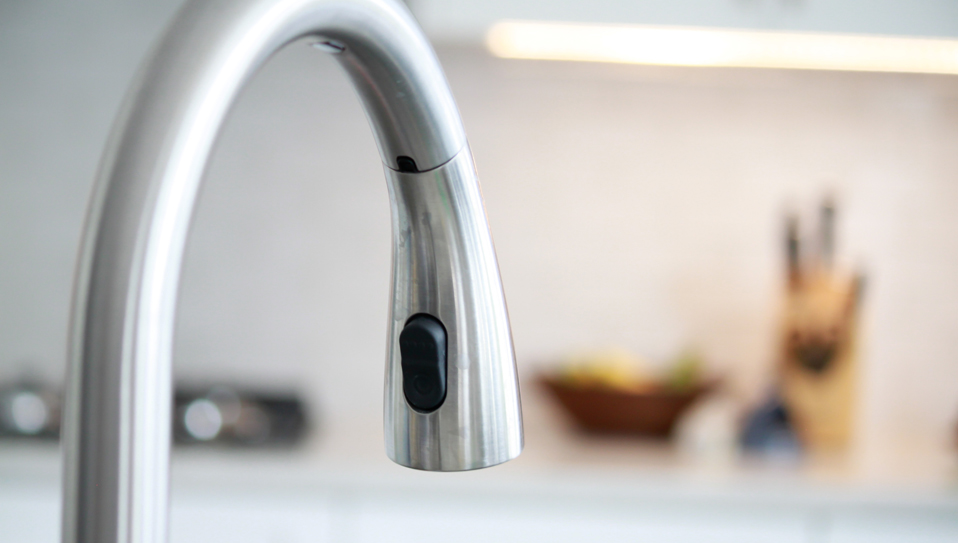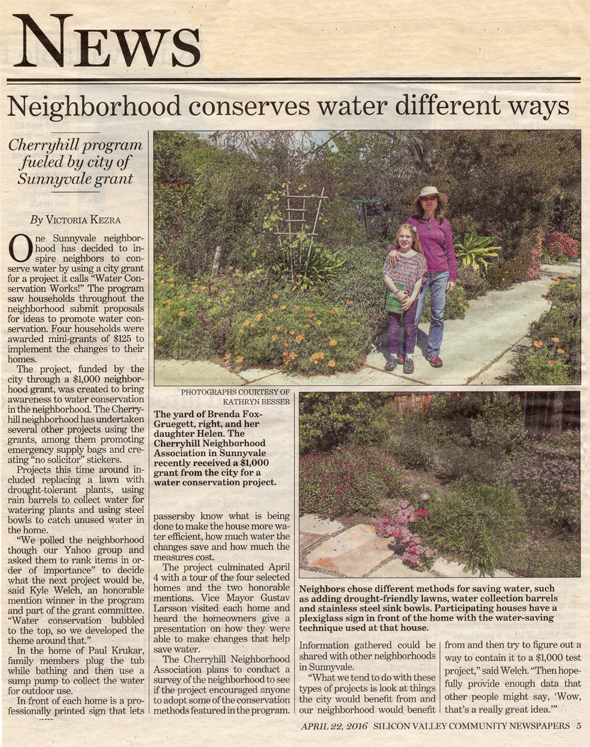2015-16 Grant: Water Conservation Works!
With this grant, we asked ourselves, “What can we as a neighborhood do to help with California water conservation efforts?”
Our answer was to encourage neighbors to test out ideas with a bit of support from our Water Conservation Works! program.
WHAT: 4 mini grants ($125 each) for water conservation efforts that would be visible to neighbors (front, side of property) – identified by weather proof signs. The projects may be any size in terms of overall budget, our stipends would cover $125 of expenses.
GOAL: Inspire more Cherryhill neighbors to adopt similar measures in the coming year!
Below are our four mini-grant winners and honorable mentions. Each residence displayed a waterproof sign to identify them within the neighborhood.
“Water Conservation Works!” Mini-grant winners
Taking a 5-gallon shower bucket to the next level
PAUL KRUKAR
I use a 1/2 HR, float-activated sump pump after family members take a shower in the tub. They close the drain during the rinse cycle of showering or bathing. I plug in the pump, lower the pump into the tub and lift the float to activate the pump. A standard garden hose threaded to the pump discharges the grey water to a 55-Gallon barrel just outside the bathroom. The hose runs through a small hole in the window screen.
A good online resource regarding products safe for grey water is :
http://greywateraction.org/contentgreywater-friendly-products/
Rain catchment barrel used in garden landscaping
WILMA CHU
A 65 gallon-rain barrel will be placed in the northwest corner of my yard adjacent to a downspout and visible from sidewalk.
After doing some research on rain catchment systems, I located barrels made in the USA of 100% recycled materials by Rain Water Solutions of North Carolina. These rain barrels are currently being used in municipal water conservation projects in Texas, Iowa as well as Oakland and San Francisco. Updated landscape work is currently underway at my residence. This rain barrel will be installed with others to maximize water conservation efforts in addition to replacing lawn with native and drought-tolerant plants and establishing a grey water usage plan for landscape plants.
Replacing a thirsty lawn with native, drought-tolerant plants
JENIFER DAMEWOOD & STEVE HOWARD
In 2014, we replaced our lawn with drought-tolerant landscaping and are very happy with it! Not only does it look attractive and require very little maintenance, our water bill has been significantly impacted by less water needed for the yard.
HONORABLE MENTION TO KYLE WELCH WHO WAS PART OF OUR GRANT SELECTION COMMITTEE:
I removed the front lawn and replaced it with low water plants (Blue Mediterranean Fan Palms and a Mexican Grass Tree) in gravel. There is a small area of landscaping in the front that gets a little more water than the gravel area, and that is under the magnolia tree. In that area I put down mocha mulch to retain as much moisture as possible. I also installed three rain barrels in the back yard.
Easy low-tech solutions using items found in your home
MIRA DABROWSKI
I keep a steel bowl in kitchen sink where I catch hand and veggie washing water for plants. Any bowl will do but it’s nice to have one that matches the sink and looks attractive at the same time. I dump the bowl into an exterior container if I don’t have an immediate area that needs watering. We also use a bucket in our shower and use the warm-up water in a number of ways including toilet flushing and watering indoor and outdoor plants.
HONORABLE MENTION TO SUNIL PRIYADARSHI FOR A GREAT LOW-TECH IDEA:
If you have an old toilet (which uses more water), you can make them use less water by inserting a 1-liter or 1/2-liter soda bottle filled with sand into the top tank to displace some of the required water.
Simple steps to save water indoors
- Turn off the faucet while you are brushing your teeth and shaving.
- Take shorter showers. You will save 2.5 gallons of water EACH MINUTE.
- Turn off the shower after soaping up, then back on to rinse.
- Keep a large bucket in the shower to capture water as you wait for it to warm up.
- Check toilets and faucets for leaks. Running toilets can waste 2 gallons A MINUTE while leaky faucets can waste THOUSANDS of gallons. Put a little food coloring into the tank, if the color trickles into the bowl, repair the leak.
- Do not use the toilet as a wastebasket. Only toilet paper goes in the toilet.
- Only wash full loads of laundry and dishes.
- Install water-efficient faucet aerators and shower heads in your kitchen and bathrooms.
- Rinse fruits and vegetables in a pan instead of using running water.
- Scrape, don’t rinse, dishes before putting them in the dishwasher or use a damp paper towel. With modern dishwashers and detergents, there is no need to do a “pre-clean.”
- Limit the use of the garbage disposal. Save the scraps to run the disposal once or place them in a compost pile.
- Put a large bowl in the sink to capture water and empty into a bucket to reuse water for plants.
- Install a “gray water” system to reuse water from bathtubs and showers, clothes washing machines and sinks which can then be used in landscapes.
- Keep a pitcher of drinking water in the refrigerator. Running water to cool it off for drinking is wasteful.
- Replace your old, front-loading clothes washer with a high-efficiency model. Apply online at www.waterenergysavings.com or call the Water District’s Water Conservation Hotline at (408) 630-2554.
- Replace your toilet—rebates available! For more information, call (877) 874-8479.
Simple steps to save water outdoors
- Plant native or drought-tolerant plants that require less watering. Native plants promote healthier local ecosystems.
- Check for leaks: pipes, sprinkler heads, and valves.
- Use a broom to sweep off pavement. Using a hose to wash sidewalks, driveways and patios wastes money and water.
- Apply organic mulch around plants to reduce moisture loss and keep weed-growth down and promote a healthier soil environment.
- Water during cool parts of the day. Early morning is the best time since it helps prevent fungus.
- Avoid watering on windy and rainy days.
- Deep soak your lawn to ensure moisture reaches the roots. Light sprinkle watering evaporates quickly and encourages shallow root systems that need more frequent watering.
- Water your lawn only when it needs it. You can test it by stepping on it. If it springs back up, it does not need watering.
- Use drip irrigation in larger gardens with weather- based irrigation control (WBIC). To Pre-Qualify for a REBATE, call the Water District’s Water Conservation Hotline at (408) 630-2554.
- Install a simple rain barrel water catchment system. Rainwater harvesting systems can provide supplemental water for landscapes and pets.


